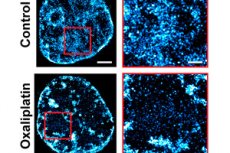New publications
New approach blocks cancer cell adaptation and doubles the effectiveness of chemotherapy
Last reviewed: 27.07.2025

All iLive content is medically reviewed or fact checked to ensure as much factual accuracy as possible.
We have strict sourcing guidelines and only link to reputable media sites, academic research institutions and, whenever possible, medically peer reviewed studies. Note that the numbers in parentheses ([1], [2], etc.) are clickable links to these studies.
If you feel that any of our content is inaccurate, out-of-date, or otherwise questionable, please select it and press Ctrl + Enter.

In a completely new approach to cancer treatment, biomedical engineers from Northwestern University have doubled the effectiveness of chemotherapy in an animal experiment.
Instead of attacking the cancer directly, this unique strategy prevents cancer cells from evolving to become resistant to treatments — making the disease more susceptible to existing drugs. Not only did this approach virtually eradicate the disease in cell cultures, it also significantly improved the effectiveness of chemotherapy in mouse models of ovarian cancer.
The study was published in the journal Proceedings of the National Academy of Sciences.
“Cancer cells are great adaptors,” says Vadim Backman of Northwestern University, who led the study. “They can adapt to almost anything. First, they learn how to evade the immune system. Then they learn how to resist chemotherapy, immunotherapy, and radiation. When they become resistant to these treatments, they live longer and acquire new mutations. We didn’t want to kill the cancer cells directly. We wanted to take away their superpower — their innate ability to adapt, change, and evade.”
Backman is the Sachs Family Professor of Biomedical Engineering and Medicine at Northwestern University's McCormick School of Engineering, where he directs the Center for Physical Genomics and Engineering. He is also a member of the Robert H. Leury Comprehensive Cancer Center, the Institute for the Chemistry of Life Processes, and the International Nanoscience Institute.
Chromatin is the key to cancer survival
Cancer has many distinctive features, but one trait underlies them all: its relentless ability to survive. Even when the immune system and aggressive medical treatments attack a tumor, the cancer may shrink or slow in growth, but it rarely goes away completely. Although genetic mutations contribute to resistance, the mutations occur too slowly to account for the rapid response of cancer cells to stress.
In a series of studies, Backman’s team uncovered a fundamental mechanism that explains this ability. The complex organization of genetic material called chromatin determines cancer’s ability to adapt and survive even the most powerful drugs.
Chromatin, a group of macromolecules including DNA, RNA, and proteins, determines which genes are repressed and which are expressed. To pack the two meters of DNA that make up the genome into a space just a hundredth of a millimeter inside the cell’s nucleus, chromatin is extremely compacted.
By combining imaging, modeling, systems analysis, and in vivo experiments, Backman's team found that the 3D architecture of this package not only controls which genes are activated and how cells respond to stress, but also allows cells to physically encode a "memory" of gene transcription patterns into the geometry of the package itself.
The three-dimensional arrangement of the genome acts as a self-learning system, similar to a machine learning algorithm. As it “learns,” this arrangement is constantly reorganized into thousands of nanoscopic chromatin packing domains. Each domain stores a piece of the cell’s transcriptional memory, which determines how the cell functions.
Reprogramming Chromatin to Enhance Chemotherapy
In the new study, Backman and his colleagues developed a computational model that uses physical principles to analyze how chromatin packing affects a cancer cell’s likelihood of surviving chemotherapy. By applying the model to different types of cancer cells and classes of chemotherapy drugs, the team found that it could accurately predict cell survival—even before treatment began.
Because chromatin packaging is critical for cancer cell survival, the scientists asked themselves: what would happen if the packaging architecture were altered? Rather than creating new drugs, they screened hundreds of existing drugs to find candidates that could modify the physical environment inside cell nuclei and influence chromatin packaging.
Ultimately, the team chose celecoxib, an FDA-approved anti-inflammatory drug that is already used to treat arthritis and cardiovascular disease and that, as a side effect, alters the packaging of chromatin.
Experimental results
By combining celecoxib with standard chemotherapy, the researchers saw a significant increase in the number of cancer cells that died.
In mouse models of ovarian cancer, a combination of paclitaxel (a common chemotherapy drug) and celecoxib reduced the rate of cancer cell adaptation and improved tumor growth suppression, outperforming the effect of paclitaxel alone.
"When we used a low dose of chemotherapy, the tumors continued to grow. But once we added a candidate TPR (transcriptional plasticity regulator) to the chemotherapy, we saw much more significant growth inhibition. It doubled the efficacy," Backman said.
Possible Prospects
This strategy could allow doctors to use lower doses of chemotherapy, reducing severe side effects. This would significantly improve patient comfort and their experience of cancer treatment.
Backman believes that reprogramming chromatin could be key to treating other complex diseases, including cardiovascular and neurodegenerative diseases.
